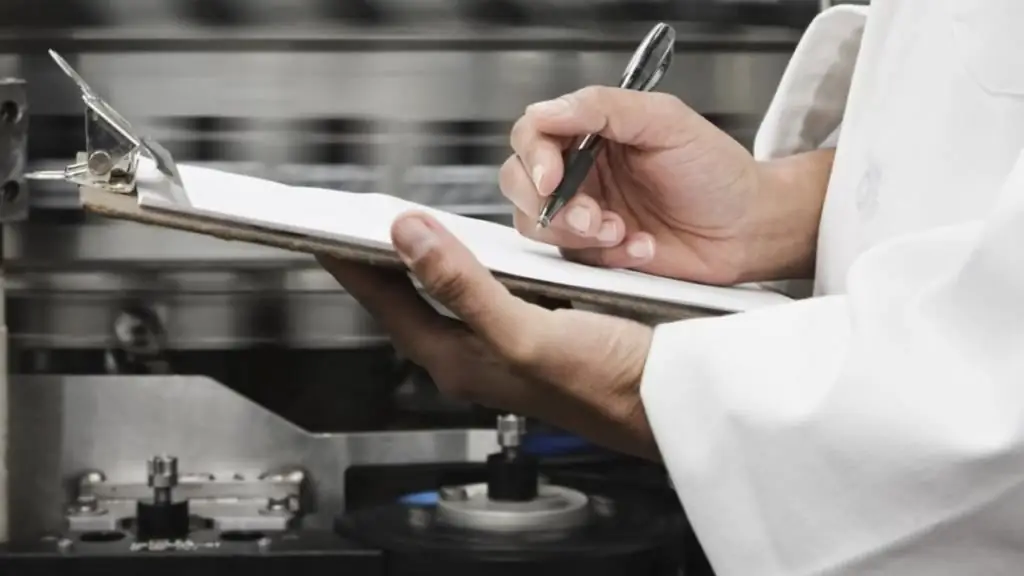2025 Author: Howard Calhoun | [email protected]. Last modified: 2025-01-24 13:10:43
Quality control is one of the most important stages of the production process, which is not directly related to the manufacturing operations of products, but provides the necessary information about its consumer properties. At first glance, the technology for assessing quality characteristics depends entirely on the type of product and its features. But it is precisely in order to optimize quality control in different areas that they use the concept of unifying the rules for evaluating a product. And in this context, it is important to understand what qualimetry is? This is a rather multi-layered and ambiguous concept, but in general terms it can be represented as a quality regulation. Below this term will be disclosed in more detail with all the nuances and aspects of application.
Basic concepts of qualimetry

First of all, it is important to decide that qualimetry is the science of quality. Accordingly, the central concept for consideration will be quality, expressed in a huge arrayproperties and characteristics. Again, if we consider each subject for the application of qualimetry in its closed system of assessments, then the quality will be expressed by specific indicators. The meaning of qualimetry is to develop the principles of an evaluation system that can be applied universally to all objects of research or individual product groups. An object of qualimetry can mean both a certain characteristic (a system of properties and parameters) and a conditional product to which the quality control method will be applied. The concept of the qualimetric aspect is also important, which already reflects the technological side of the application of qualimetry methods, combining such systemic concepts of assessment as structure, property, dynamism, etc. We can say that this is a universal framework that contains a matrix of assessment parameters with a certain hierarchy and links between individual indicators.
Application of qualimetry

Difficulties in considering qualimetry as a science in the USSR were reduced to the contradictions of its presentation from the point of view of practical use. Theoretically, a universal rating system can be applied to any object of nature, having initially decided on the criteria and parameters of the study. The main condition is that this object, in principle, allows the use of the concept of quality. But what is qualimetry in practice of its use today? This is a kind of analysis tool that allows you to establish the compliance of one or more properties of an object with a certain quality standard. The latter can be a regulation, standard, technical document, design solution, etc. Moreover, the areas in which such a model of quality assessment operates are extensive and go far beyond the traditional areas of the national economy.
Qualimetry measurements
It is impossible to determine how an object corresponds to quality indicators without a measurement system. Measurement and evaluation are the basic concepts of qualimetry, but their relationship is fundamentally different from other contexts in which the same terms are used. In this case, the measurement is not only a measured value for the technical designation of a certain parameter. Through the examination of the subject, the user can obtain information about its characteristics as corresponding to the standard. For example, what is qualimetry in relation to the assessment of the quality of a reinforced concrete structure? Firstly, it is a complex of technical and measuring tools that will provide an array of operational indicators of a given facility. Among them there will be several types of strength indicators, mass, dimensional parameters, etc. Secondly, qualimetry, based on the information obtained and reference indicators, should evaluate the design, that is, how good it is. Moreover, the deviation itself, even with a high coefficient, does not always mean that the object is of low quality. So, if the compressive strength of reinforced concrete exceeds the standard value, then the structure is recognized as being of high quality.

Problems of qualimetry
The application of qualimetry and its technologies is based onwide functional base, which, in turn, is aimed at solving the following array of tasks:
- Selection and justification of quality indicators, as well as ways to optimize them.
- Development of principles for building complex quality assessment systems, the indicators of which can be applied to different objects of research in a generalized form.
- Development of quality quantification systems. Qualimetry is still largely a conventional tool in terms of application, so it is important for professionals working in this field to strive to create systems with specific forms and quality reflection characteristics.
The range of tasks of modern qualimetry to a large extent depends on the production conditions, objects of study, assessment purposes and, in general, on the model of applying one or another quality control method at the enterprise.
Varieties of qualimetry

A more accurate formulation of the goals and objectives of qualimetry will also help its division into areas of use. In particular, the following types of modern qualimetry are distinguished:
- General. Engaged in the development of general theoretical problems, including theories of evaluation and measurement, systems of concepts and axiomatics.
- Special. Narrowly focused qualimetry in terms of scope and applied assessment methods. For example, in social qualimetry, an extensive layer of methods can be used, including expert, index, probabilistic-statistical, etc.as a result of the complex processing of the data obtained, an expert opinion is issued on the quality of a particular social environment. Moreover, the assessment systems themselves can be multifaceted, which also leads to the presence of conventions when formulating a conclusion about the qualitative state of the object of study.
Subject Qualimetry
Actually, the classification of the evaluation system, the sign of which will be the object of study. It can be a simple technical part with clear parameters, which is produced on a lathe as part of the general assembly of a car, or an urban planning project of a metropolis with a huge array of initial data, to which different rating systems are applied.
Basic methods of applying qualimetry

Even in the field of real activity, modern enterprises use a huge number of different approaches and methods to evaluate the quality of their products. However, the main methods of qualimetry presented below are the most widely used:
- Exact method. It involves the use of all reasonable theories, techniques and methods that reduce the error and increase the reliability of the results of the study. The process is characterized by the use of multi-level assessment tools, which assume multiple summation of a wide array of initial data, including those related to environmental conditions.
- Simplified method. In this case, a high degree of error and a low degree of reliability of the results are allowed.research. This is due to the fact that simple schemes and evaluation tools are used that require less time and material and technical resources to determine qualimetry indicators within a specific model.
- Approximate method. According to the parameters of error and laboriousness of application, this is an intermediate variant of estimation, located between the exact and simplified methods. A feature of this approach is the implementation of a single summation or integration of the properties of an object without taking into account environmental conditions.
Expert and non-expert methods
In streaming quality control systems, when servicing large volumes of numerical indicators, an evaluation system is used that involves the knowledge of experts. This approach is technologically easy to use, but organizationally it is a costly and unreliable method. The high share of the error is largely associated with the need to involve various qualified specialists, which requires the creation of several data processing channels. The non-expert quality assessment method in qualimetry is analytical and does not require the involvement of third-party specialists. There is a well-established data processing model in automatic mode, which allows achieving high accuracy of results. The only thing that may require the involvement of experts is the task of building a tree of properties, which is not directly related to the process of evaluating the qualitative characteristics of an object.

Mixed methods
Combinedan approach that combines separate principles of expert and non-expert assessment methods. As a rule, narrowly focused processing of numerical data with the involvement of specialists takes a smaller share in the overall process. This is the most costly approach, since its implementation requires much more organizational resources precisely for the technological unification of fundamentally different models of studying an object. However, the mixed method of evaluation has a significant advantage. It is expressed in the principles of qualimetry control, which allow the formation of complex systems of judgments about the object.
Conclusion

From generalized theoretical models with primitive means of application, qualimetry has made a huge evolutionary step towards a high-precision diverse assessment of an object with a high proportion of reliable information about its quality. Today it is not just a tool in quality control systems, but one of the competitive factors. After all, what is qualimetry from the point of view of a large commodity producer who is fighting for new market areas, trying to please the consumer? At a minimum, this is a way to increase the attractiveness of your products through the optimal model for identifying its shortcomings and minimizing defects. But at the same time, modern qualimetry provides a lot of opportunities for optimizing the production itself and part of the logistics processes, so its methods are increasingly entering the areas of management and design of production infrastructure.
Recommended:
Quality as an object of management: basic concepts, levels, planning methods, objects and subjects

Analysis of product quality as an object of management is especially relevant if we recall the fact that a market economy reigns in our world. This system pays special attention to quality issues. The reason for this is strong competition
Assessment of the investment attractiveness of an enterprise: basic concepts, methods, principles, ways to improve

Production investments are the backbone of any enterprise. Large capital investments will allow creating or updating the existing material and technical base, replacing physically or morally worn-out fixed assets, increasing the volume of activities, mastering new types of products, expanding sales markets, etc
Horizontal communication: basic concepts, types, management methods in an organization

What is communication? External and internal business communication. Characteristics of horizontal communication, possible problems and ways to solve them. Characteristics of vertical communication: hierarchical and inverse subgroups, their description, possible problems and their solution
What is labor rationing? Basic concepts, organization, types, methods of calculation and accounting

Thinking about what labor rationing is, many of us have associations of production, an uninterrupted workflow. This term is of great importance in economic planning. And although today you can often hear the opinion that the rationing of the work of workers is an echo of the Soviet system of production, most industrial enterprises are in no hurry to abandon the use of this tool
Object of taxation: basic concepts and essence of its definition

The object of taxation is a list of certain legal facts that determine the obligation of a business entity to pay tax for the implementation of the sale of goods. Also, the taxable object includes the import of goods into the Russian territory, the presence of property in personal possession, the receipt of an inheritance and simply income

